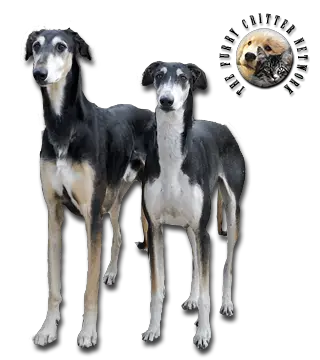Breed Standard
Head: Strong, cleanly cut, long. Flat skull. Stop not very pronounced. Strong muzzle and jaws. Lips not pendulous. Nose black or dark in color, depending on coat color.
Ears: Medium-sized, fairly narrow. Tips easily reach the inside corners of the eyes when outstretched.
Eyes: Fairly large, almond-shaped, dark (ranging from dark brown to amber). Edge of eyelids black or dark in color.
Body: Long. Long, muscular, powerful neck. Pronounced withers. Spacious chest. Wide, muscular loin. Tuck-up. Straight back. Gradually sloping, long, muscular, broad croup.
Tail: Long, thick at the base, carried low at rest. Tip must form an upward-curving sickle or a complete ring.
Hair: Fairly hard, neither wirehaired nor silky. Variable in length. Longer on the withers and shorter on the sides of the trunk. Longer on the hindquarters and underside of the tail, forming culottes and a brush.
Coat: All colors are allowed.
Size: Dog: 70 to 80 cm. (27.5-31.5 in).Bitch: 68 to 75 cm (27-29.5 in).
Weight: Approx. 40 kg (88 lb).
History
The first records about the existence of greyhounds in Poland come from the times of Gallus Anonymus. 12th or 13th century is considered the beginnings of the race's existence. Originally, these dogs were used for hunting birds. The Polish Greyhound was the favorite dog of the Polish nobility.
After World War II, breeding of this breed disappeared. Hunting with greyhounds was forbidden, and greyhound dogs were liquidated. Their keeping and breeding has been covered with a special permit, this provision still applies. From the 70s of the twentieth century began to reproduce the breed. Contemporary Polish Greyhound breeding was started by Stanisław Czerniakowski, who bought two females, Taiga and Struska and one dog, Elbrus in the vicinity of Rostov-on-Don. From the association of Taiga and Elbrus the first litter of Polish greyhounds was born.
In 1989, the breed was entered in the register of the Federation Cynologique Internationale (FCI).
Behavior
Polish Greyhounds have some similarities to other sighthounds, in that they are not overly active dogs, unless they have a purpose to be active. Such as when they are running and chasing prey. In other ways they are very unlike the typical sighthound. They can be dog aggressive, due to their being bred to hunt wolves and can be very territorial. They have a strong pack instinct and will not always accept new dogs into their home.
They can be very good guard dogs in the home and they create strong bonds with their owners; in some, this instinct is so strong, they will not accept strangers coming into the home. They enjoy a good exercise regimen, walking them daily is a very good way to do this. They love to run, of course, and if they can no longer be used for actual hunting, (many locations prohibit this) then a decent facsimile would be participating in the performance sports like coursing and racing. Between running activities, they like nothing better than lounging on the couch or bed. They are obedient and easy to train, although they can be stubborn and willfull. This is not the best breed for the novice dog owner. They need early socialization and firm, fair guidance from their owners.
He needs space and lots of exercise, as well as regular brushing.
Function
Hunting Dog, Companion Dog.
Health
The biggest health concern for these dogs are cardiomyopathy and cancer. It is recommended to get cardiac blood and urine analysis yearly physical examination for optimal health. They are also subject to bloat, and muscle injuries.






